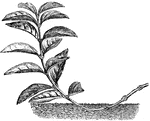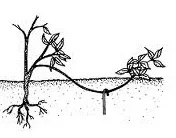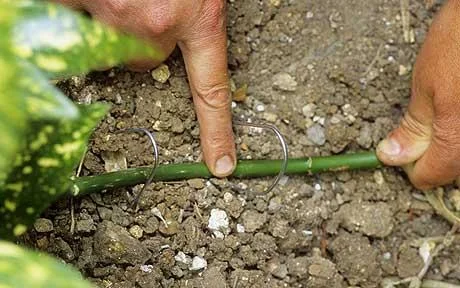Propagation by cuttings is considered one of the oldest methods often used by gardeners. The essence of such propagation is to stimulate the growth of roots on the stem before separating part of the stem from the mother plant.
Most often, this method is used for ampelous plants and plants with long flexible stems. The only disadvantage of propagation by cuttings is the long-term process.
This method of vegetative reproduction is the simplest. With this method of propagation, there is no need to carefully control the environmental conditions to ensure the formation of roots.
When using propagation by cuttings, it is important to choose shoots, a place and create conditions under which strong roots and new shoots will form.

Preparation of land for vegetative reproduction
The land around the mother plant, where the shoots will take root, is prepared in a special way. The soil should have good moisture retention capacity with sufficient oxygen penetration and drainage. Therefore, when obtaining vegetative leads on a regular plot in the garden (if the bed for reproduction is not specially prepared), the ground must be dug to a great depth. This will ensure good drainage and reduce the likelihood of plants getting stuck. To improve the quality of the land on heavy soils, peat or sand can be added.

The formation of roots is facilitated, first of all, by the absence of light in the regeneration zone, as well as the sufficiency of oxygen, heat and moisture. The sooner the stem of the plant is sprinkled, the faster root growth will occur (the stem should be dug in with soil as soon as possible), precisely the delay in digging is the most common cause of a weak root system in epaulettes.
Covering plant shoots with soil is a simple and effective method of propagating a large number of bushy and ampelous plants. This method is associated with minimal damage to the parent plant.
Preparation of cuttings (shoots) for rooting
Twelve months before the shoots are covered with soil, and sometimes even earlier, strong pruning of the branches is carried out. This contributes to the rapid growth of young shoots – they are best suited for rooting, they are easier to bend to the ground, in addition, they take root faster.
Shoots are usually covered with earth at the beginning of spring, as soon as the soil can be cultivated.
From 10 to 60 cm, depending on the plant, all leaves and side shoots are removed from the top to the bottom, and the branch is bent to the ground (approximately 20 cm from its top). From the specified point, a groove with a depth of 10-15 cm is first dug and placed on the bottom, leaving the upper end of about 20 cm long bent at a right angle (if necessary, use a copper wire for fixation) and gradually reduce the groove as it approaches the mother plant. The top is covered with earth, lightly compacted and watered. It is necessary to monitor soil moisture, especially in dry periods.
Rooting of branches takes place during the growing season.
In the spring, the layer is separated from the mother plant. A new plant is formed, adapted to environmental conditions.
Plants that reproduce by cuttings: currants, gooseberries, grapes, actinidia and others; clematis, passionflower, rose, hydrangea, honeysuckle, ivy and others.

